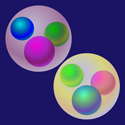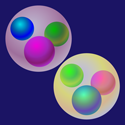Binding baryons on the lattice
Quantum chromodynamics (QCD) is the fundamental quantum field theory describing interactions of quarks and gluons. However, for bound states of quarks (for example, baryons), strong coupling at these energy scales complicates using QCD. The computational complexity increases further when considering bound states of baryons. Direct numerical simulations of QCD formulated on a spacetime lattice offer the best hopes, however, such studies are very computationally demanding.
In two papers appearing in Physical Review Letters, two groups report progress in the simulation of two-baryon systems. They study a two-baryon system with strangeness and isospin . The NPLQCD Collaboration directly computes the bound-state energy, defined as the energy difference between the lowest interacting two-baryon state and the energy of two free baryons (with one up, one down, and one strange quark) at rest. Meanwhile, the HAL QCD Collaboration obtains the bound-state energy indirectly, by first computing a two- potential. The two-baryon energies obtained by both groups are smaller than the combined mass of two isolated baryons, which confirms the bound-state nature of the two-baryon system, a so-called -dibaryon, first envisaged by Robert Jaffe in 1977.
These are the first reliable predictions of the two-baryon bound state starting from first principles, and are likely to inspire more detailed studies. A caveat: as is still the case with most lattice simulations, the up/down quark masses used in these calculations are heavier than in nature. Further computations will be needed to check whether the -dibaryon bound state exists with the up/down quarks of nature, or whether it is perhaps a near-threshold resonance. – Abhishek Agarwal and Urs Heller





